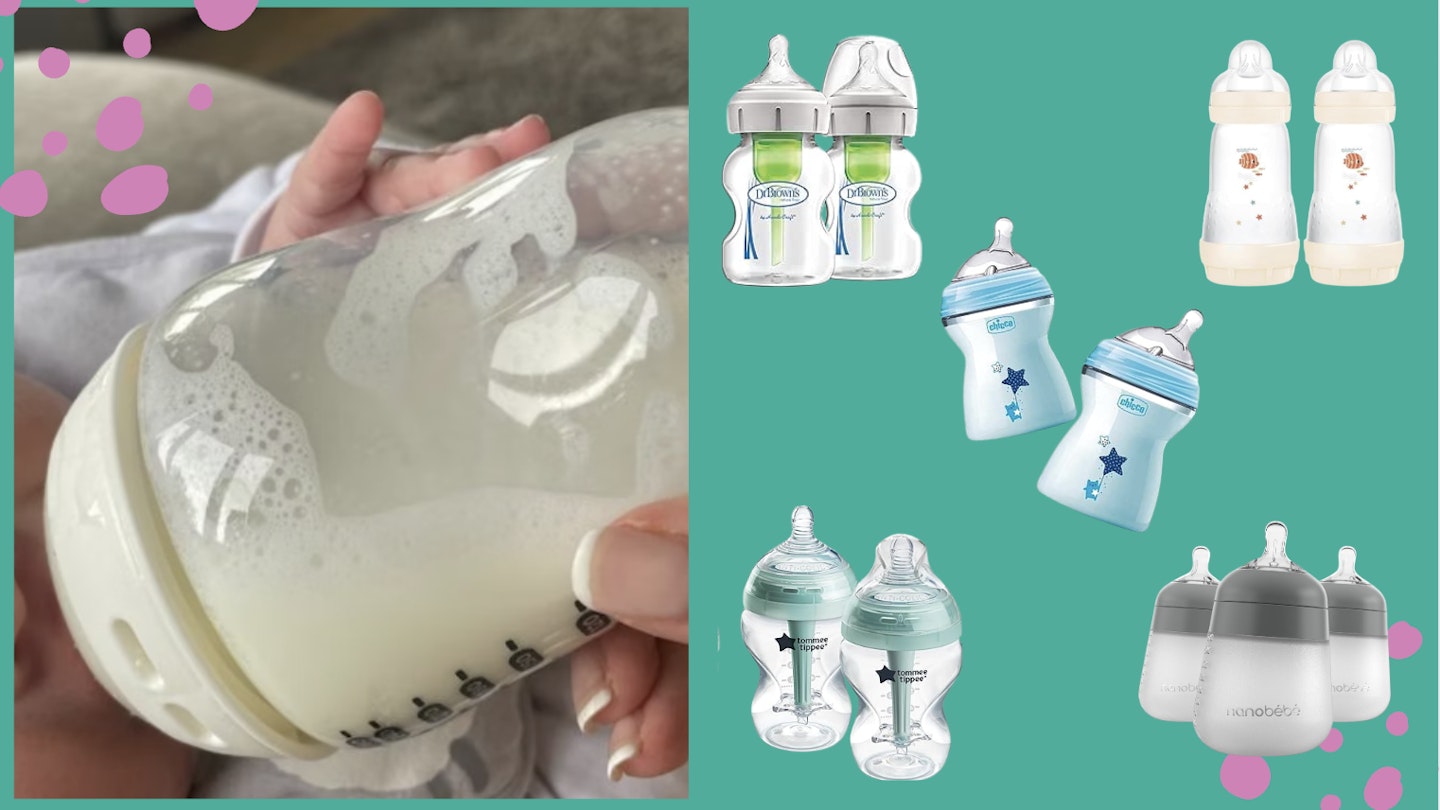How Mother&Baby tested and selected the best bottles for breastfed babies on the market in 2025.
Here at Mother&Baby, we know how important it is to find the right bottle for your little one. As mums ourselves, we've been in your position, looking at a huge array of choices and wondering which one to buy. That's why we've asked our team of Mother&Baby expert testers to evaluate each one. As well as using expert advice and guidance, and where possible our own experience as mums, we hope to guide you through the choices and give you honest feedback, so you can make the right decision for you.
Who carried out the testing?
Each of the baby bottles were tested by mums and their breastfed babies aged between 2 - 10 months old for over a month. Read more about how we test.
How were the products tested?
The bottles were primarily tested at home throughout the day and sometimes at night to assess how comfortable and easy they were for parents to use, clean, fill and how their baby took to them. The baby bottles were tested for:
• Shape: We asked our testers if the nipple was able to mimic the breast for a natural latch.
• Size: The teat's fit for the baby's mouth.
• Flow rate control: Measures how quickly milk comes out of the teat to prevent the baby from getting frustrated or choking.
• Anti-colic features: Addresses the bottle's ability to reduce air intake.
• Compatibility with breast pumps: Determines if the bottle can directly attach to a breast pump for convenient pumping and feeding.
• Safety: The bottle's materials being free of harmful chemicals like BPA.
• Budget: Considers the bottle's affordability.
Our ratings
Each product was then scored out of 5 in the following categories: ease of use, cleaning, comfort, durability and design. Here's what each rating means:
⭐ 1/5 — Poor: Didn’t meet expectations in this area at all. Major drawbacks or design issues made it hard to recommend.
⭐ 2/5 — Fair: Some useful features but significant issues. Might work for some, but we found better options.
⭐ 3/5 — Good: Did the job reasonably well, with a few flaws. Solid choice for the basics but didn’t stand out.
⭐ 4/5 — Very good: Impressive performance with only minor drawbacks. A reliable, high-quality option.
⭐ 5/5 — Excellent: Outstanding in this category. Safe, adjustable, and well-made — the best we tested.
Click the link below to see how our top-rated baby bottles compared.
Comparison table.

Medically Reviewed by: Dr Zoe Williams
Just so you know, we may receive a commission or other compensation from the links on this website - read why you should trust us.
So, you're thinking about breastfeeding? Smart move! While breastfeeding your baby can be a wonderful experience, sometimes your breasts will need a break. When they do, you'll be glad to reach for those handy bottles made for breastfed babies. I know I was.
I breastfed my son for a few weeks and but it wasn't always smooth sailing. I felt guilty and found myself caught between a rock and a hard place - wanting to breastfeed but struggling to. I eventually turned to bottle feeding and it turned out to be the best decision for me.
My son was such a hungry baby and I was worried that he wouldn't take to a bottle, so I let my mum do the first bottle feed and before I knew it, he was happily sucking away. Seeing him content was such a relief and a weight off my shoulders. My husband soon took over some of the feeds - especially those late-night ones, which helped to catch up on some much-needed sleep.
In this article:
•FAQs
From baby bottle teats that mimic breastfeeding to help breastfed babies latch, to anti-colic systems and self-sterilising bottles, there are a number of different types of bottles that may suit your baby: but where to start? Initially you may be worried that if you don’t introduce a bottle early on, your baby won’t take to it, but breastfeeding support group, La Leche League say that "While a younger baby is slightly more likely to accept a bottle than an older one, it’s not a strong effect. Most babies of all ages will accept a bottle – some with a little coaxing!"
To help guide you through the process, we've compiled a list of the top baby bottles on the market, all tried and tested by our real-life mum testers and their breastfed babies. We hope this makes your job a little easier. To gain further expert insight and useful advice on bottle feeding for breastfed babies, we spoke to Dr Zoe Williams, a practising NHS GP, author and mum. She suggests thinking of it as "learning a new skill and learning a new skill often takes practice. So if it’s a planned ‘returning to work’ scenario, then start introducing the bottle a few weeks before your start date."
We also spoke to Midwife Jo Parkington, an NHS Midwife and resident midwife for Fraupow who shares advice and helpful tips on how to help a breastfed baby take to a bottle for the first time.
Best baby bottles for breastfed babies at a glance:
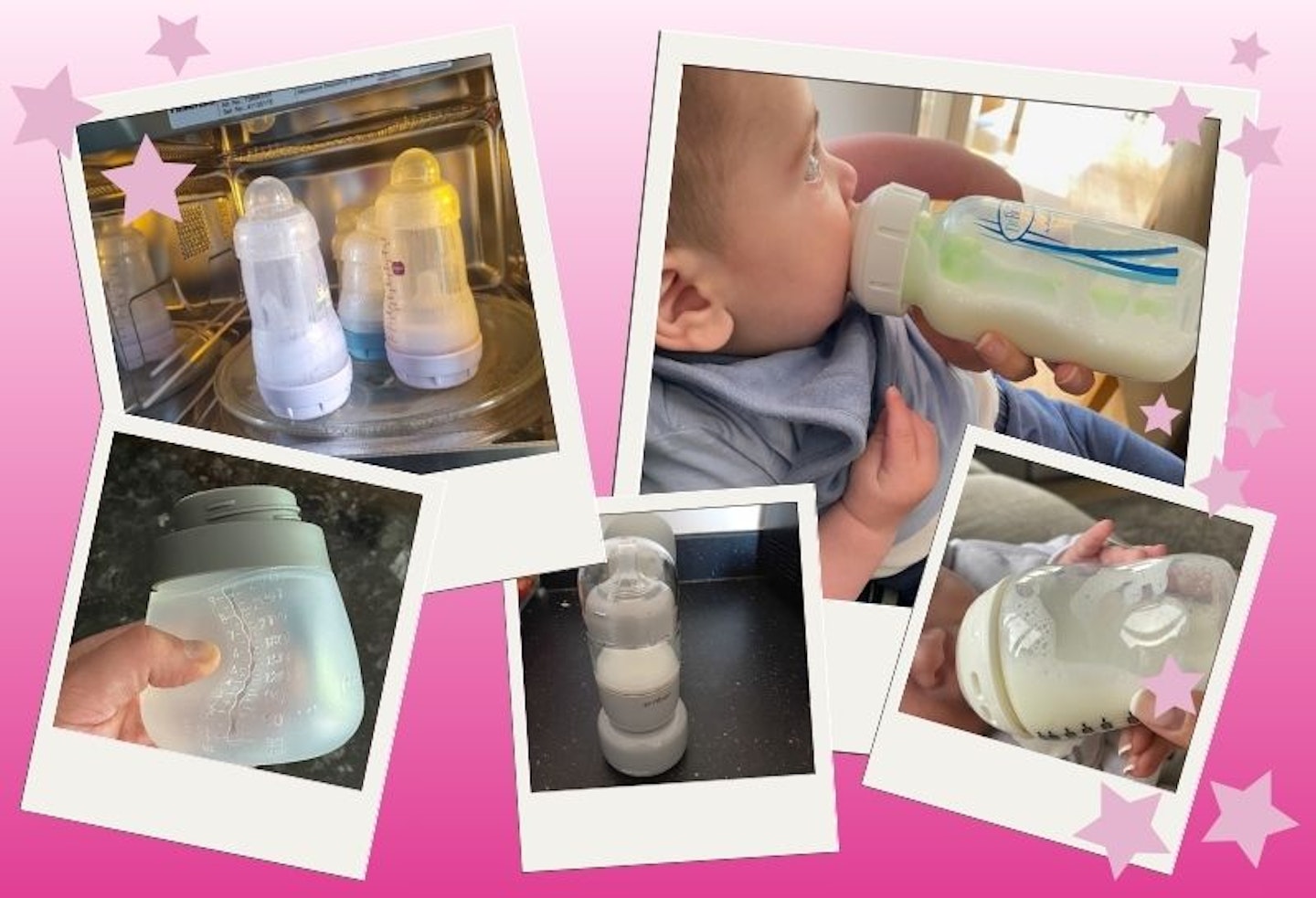
Ultimately, when choosing the best bottle for you, it can come down to a number of different factors and priorities; if your baby has colic, the MAM Easy Start Anti Colic Bottles, Dr Brown Anti-Colic Bottles and Tommee Tippee Anti Colic Bottles should be high on your list as they all scored highly with our testers for their anti-colic design. If you prefer to use glass for its sustainability benefits, Dr Brown bottles once again scored highly. For an all-in-one solution, the Ember Baby Bottle System is a warmer and bottle in one which can save you money and time. However, if you want to buy one set for your whole bottle-feeding journey, the Nuby Natural Touch Newborn Starter set scored highly for ease and value for money.
The best bottles for breastfed babies 2025
Best overall baby bottles for breastfed babies
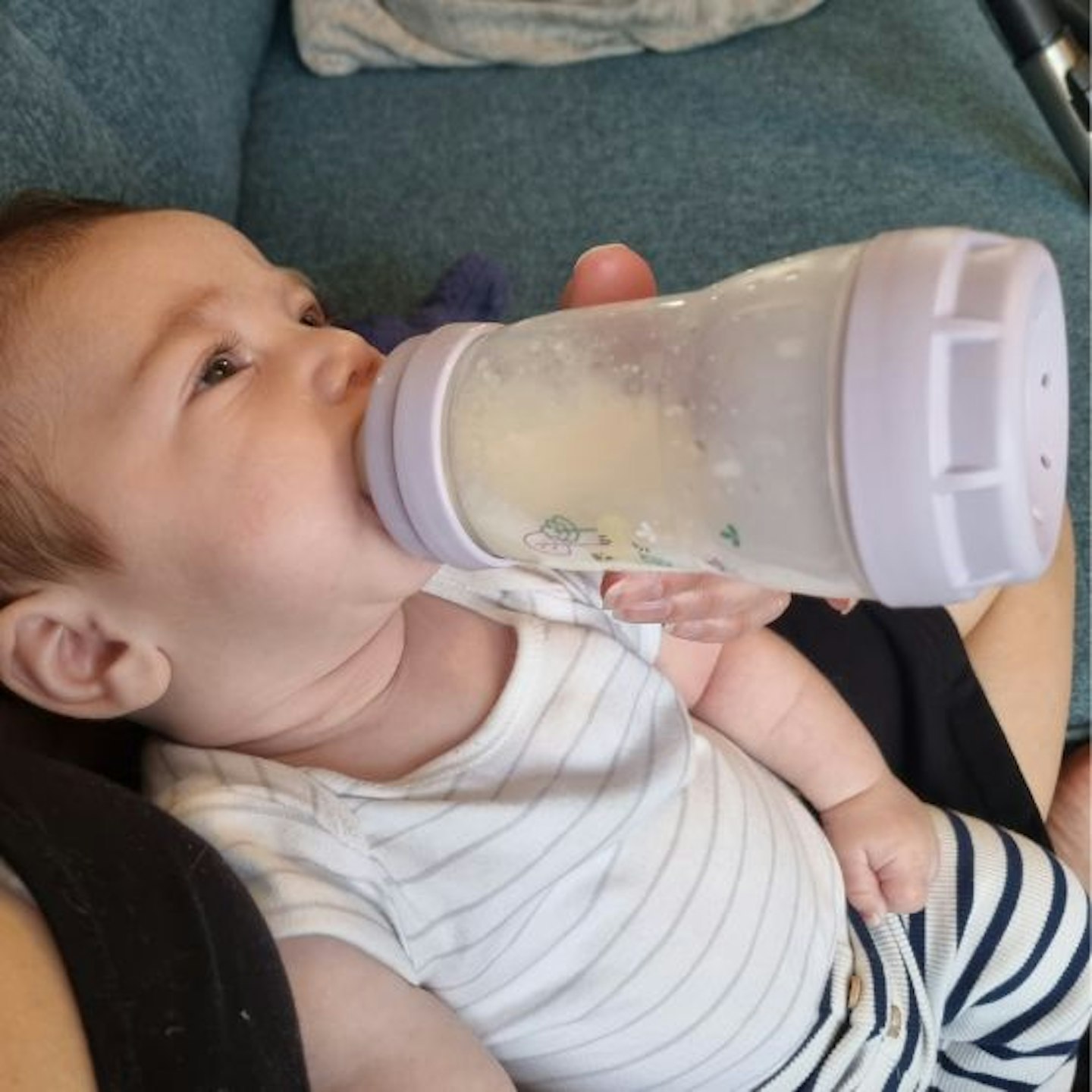 ©MOTHER&BABY
©MOTHER&BABYredirect.viglink.com
The MAM Easy Start Anti Colic 2pk 260ml was awarded Gold for Best Product for Bottle Feeding at the Mother&Baby Awards 2023 and 2024.
The MAM Easy Start Anti-Colic bottles are a particularly good choice for mums who are combining breastfeeding with bottle feeding. Our mum testers loved the ultra-soft silicone teats, which are made to mimic mum's nipple and provide a comfortable feeding experience. Tester Jade said, "The teat shape is flat on one side, and at first glance, you wouldn't think it’s nipple shaped at all, but it does make sense that the nipple is flattened when feeding. Both my children took to the teats really well after transitioning from the breast so the flat teat was great."
This was also midwife Marie Louise's recommendation, saying, "As a breastfeeding mum second time around, I have needed to express milk to help with my busy lifestyle and going back to work - my youngest is almost 10 months. I found peace of mind in the MAM easy start bottle to give him expressed breast milk, and it is no surprise to see it as mum's number one choice of bottle in 2024!" MAM reports a 94% acceptance rate of their bottles for babies who’ve been breastfeeding too, as the products offer a range of comforting features.
Our tester Jade, felt this made them better value for money, noting, "These are more expensive than some of the other well-known brands. However, my firstborn took to this bottle more easily than some of the others we tried, so for the extra few pounds, I felt it was worth it. They have also lasted a long time."
They’re also self-sterilising for quick and hassle-free sterilisation in just minutes which is great for travel. Jade loved this feature, saying, “As a mum who often visits friends and family, this is great as it means I can just use the microwave at a friend's house to sterilise the bottle." Our testers also loved the wide opening, making the bottles easy to fill and clean, making life a breeze for busy mums.
They're ideal for babies with colic as they're designed with patented ventilation holes to prevent babies from swallowing excess air, significantly reducing colic symptoms. Our mum tester, Amy, noted, “They are very hygienic, and I would particularly recommend them to a mum whose child has colic, as we found these were the only bottles that helped.”
Jade did note that the measurements on the side of the bottle only start at 60 ml. "As someone who likes to keep track of how much my child is drinking at each feed, I found it difficult to accurately check how much was left in a bottle should he not finish the full feed."
Read our full MAM UK Easy Start 260ml Bottle review
Pros
- Ventilation holes to ensure your baby isn't inhaling too much air, improving colic
- Skin Soft technology teats that are designed to feel just like a mother's skin
- Self-sterilising in the microwave is so great for travelling
Cons
- It can take a while to wash as there are a few components to take apart
| Volume: | 260ml |
| Materials: | BPA free |
Best baby bottles for breastfed babies with a unique design
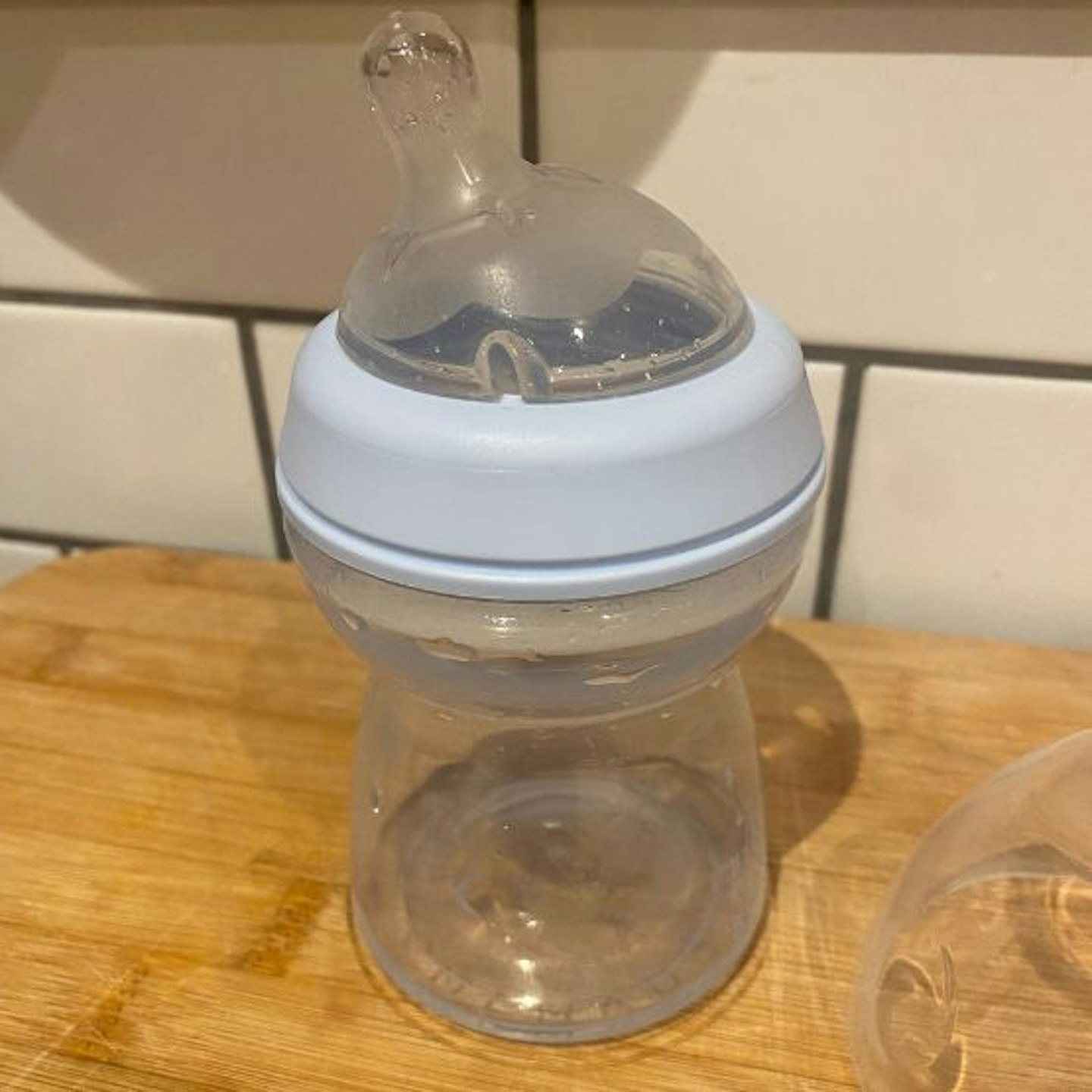 ©MOTHER&BABY
©MOTHER&BABYThese bottles are perfect for breastfeeding mums, with a soft, nipple-like teat that gives your baby an excellent slow flow. In addition to the soft teat and measured flow, the nipple is on the side rather than in the middle of the bottle – according to Chicco this improves comfort and ease of feeding and replicates the instinctive way baby feeds.
Our mum tester, Rebecca, found this to be the case, saying, "The benefits of this bottle are the leak-proof design, anti-colic feature (my baby did not stop for air mid gulps), and teat that is angled, mimicking a nipple that makes it more appealing for the baby to latch."
While Rebecca's feedback after testing this bottle was positive on the benefits for her baby, she had mixed reviews of the cleaning, explaining that "the four-part design simplifies cleaning, but the large size posed a challenge for one-handed assembly."
While she didn't test it with a high-temperature steriliser, she felt it worked well to sterilise it with a UV steriliser. She did note that "a smaller sized bottle would be useful for newborns or young babies due to the smaller volume of milk needed per feed."
Pros
- Uniquely designed teat to mimic the breast
- Has a double anti-colic valve to prevent the baby from swallowing too much air
- Cleans well and easily
Cons
- Tricky to reassemble with one hand
| Volume: | 250ml |
| Materials: | Silicone, BPA free |
3.
Nuk Perfect Match Baby Bottles
Best baby bottles for breastfed babies with built-in temperature control
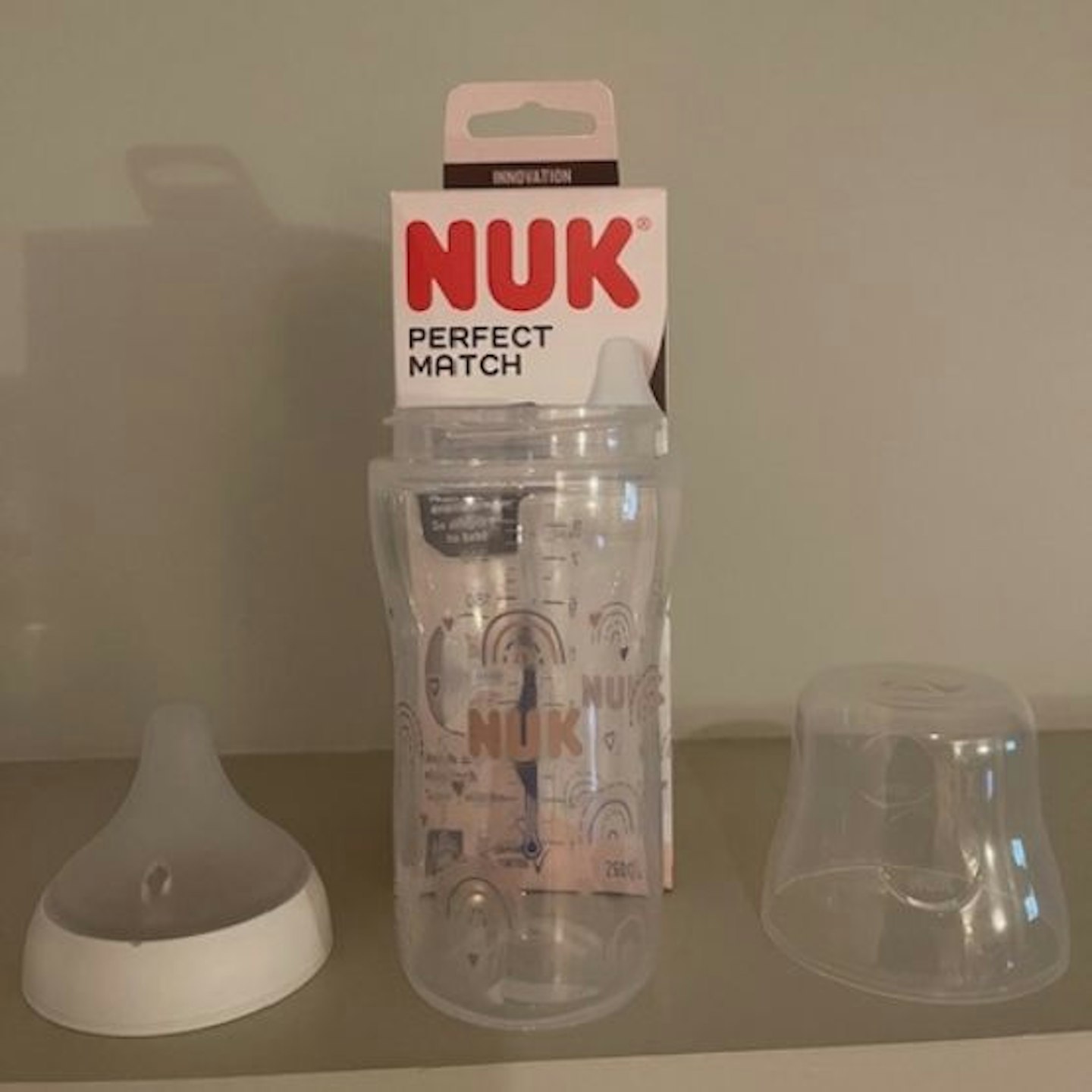 ©MOTHER&BABY
©MOTHER&BABYThe Nuk Perfect Match bottles are designed to adapt to your baby’s needs. They feature a soft, skin-like material and a super-thin, flexible teat that moulds perfectly to your baby’s palate. These features tend to improve acceptance rates and more importantly, make them more appealing to breastfed babies. Our mum tester, Olivia, noted this as a highlight, saying, "The Nuk bottle has been brilliant for my three-month-old baby. The silicone teat is super soft and has made the transition from breast to bottle a lot smoother than other bottles tried on the market. My baby has taken to this bottle really well, and I believe it is the shape of the teat that has helped." They also include an Anti-Colic valve to ensure an even flow, which tester Olivia rated highly. "The anti-colic valve ensures feeding without pain and a much happier baby."Olivia picked out the temperature control as being both helpful and reassuring as the built-in Temperature Control Indicator on the side of the bottle changes colour from blue to white when the bottle's contents are too hot. "I have been impressed with the temperature control indicator on the bottle; this changes colour if the milk is too hot and is a reassuring addition for a first-time mum learning as they go!"
While testing the Nuk Perfect Match bottle, she didn't notice any leaks and found it could withstand the high temperatures of sterilisation. She pointed out that the bottle was not dishwasher-friendly, and while this wasn't an issue for Olivia, it's something you might want to bear in mind. She also noted that cleaning it is easy thanks to the simple 4-part system, which can be easily taken apart and reassembled, though she did admit that she "hasn't quite mastered the one-hand assembly of it yet, but it is just as easy as other bottles trialled so far." Despite that, the Nuk Perfect Match has gained high praise after testing, with Olivia concluding, "I hope this bottle lasts the test of time as it is definitely a firm favourite in this household."
Pros
- Built-in temperature control indicator for added peace of mind
- The teats are thin and flexible to mimic the breast and improve acceptance rates
- The anti-colic valve reduces colic symptoms by regulating the flow
Cons
- Not suitable for the dishwasher so it will need sterilising in another way
| Volume: | 260ml |
| Materials: | BPA free |
Best baby bottles for breastfed babies for value for money
 ©MOTHER&BABY
©MOTHER&BABYredirect.viglink.com
Whether you're feeding with a bottle once a day between breastfeeds or want to transition to more regular bottle feeding, this starter set gives you everything you need to set off on a bottle-feeding journey, including two 150ml, two 260ml bottles, a soother and a bottle brush. Our tester, Natalie, appreciated the comprehensive nature, saying, "I like that the set includes different-sized bottles and teats that grow with the baby to ensure continuity in the feeding journey. Great value for money with this set."
This set is well-designed for breastfed babies as the soft, silicone teats are designed to mimic the breast to help promote a good latch, making them ideal for switching between breast and bottle. In addition, the vented design and anti-colic tubes work to draw air away from the milk, so the Tommee Tippee Advanced Anti-Colic bottle has gained the praise of many parents with colicky babies, with over 80% of testers saying it helped their baby’s colic symptoms.
Our tester, Stacey, agreed, saying, "I did notice a change in my baby’s colic symptoms after using the bottles, which I am so pleased about - I have a much happier and more comfortable baby!" “As soon as we started feeding him with these, we could tell these would do the job” one mum tester said. “Compared to the regular bottles, your baby will need to work harder to get the milk which means less air going to his stomach” she continued. Stacey did notice some leakage when shaking the bottles but none when feeding her 4-month-old. "I used the bottle to mix the formula powder and hot water, and I did find that when I shook the bottle to mix it all together some liquid leaked from the lid. It did leave a little bit of clearing up and it is something to be cautious of when making bottles up. I did not notice any leaking when using the bottle to feed the baby, though."
The only downside our tester, Stacey, found was that these bottles require a bit more cleaning and assembly steps compared to other bottles. "Due to the anti-colic function of the bottle, there are more components than other standard bottles that I have used." Like Stacey, our tester Natalie found that the anti-colic elements of the bottle made it trickier to reassemble one-handed, "Reassembly is tricky one-handed - especially when using the anti-colic venting tube - it needs two hands to ensure everything is in place." But she did note that having the full set made them easy to clean. "With the included brush and teat cleaner, I feel like every part of the bottle gets clean. Super quick and easy to sterilise using the microwave. I also love the included table for multiple bottles so that I can sterilise all of them in one go." She goes on to say that "Sterilising didn't warp or change the bottles and components or cause the writing to rub off."
Read our full Tommee Tippee Advanced Anti-Colic Newborn Starter Set Review
Pros
- Available in a range of colours
- Award-winning, soft silicone, breast-like teat makes it easier for breastfed babies to latch
- Anti-colic valve reduces excessive air flow to reduce colic symptoms
- Different flow rates to keep up with your growing baby
Cons
- Tricky to reassemble one-handed due to the multiple parts
| Volume: | 3 x 150ml and 3 x 260ml |
| Materials: | BPA Free |
Best breast-shaped baby bottle for breastfed babies
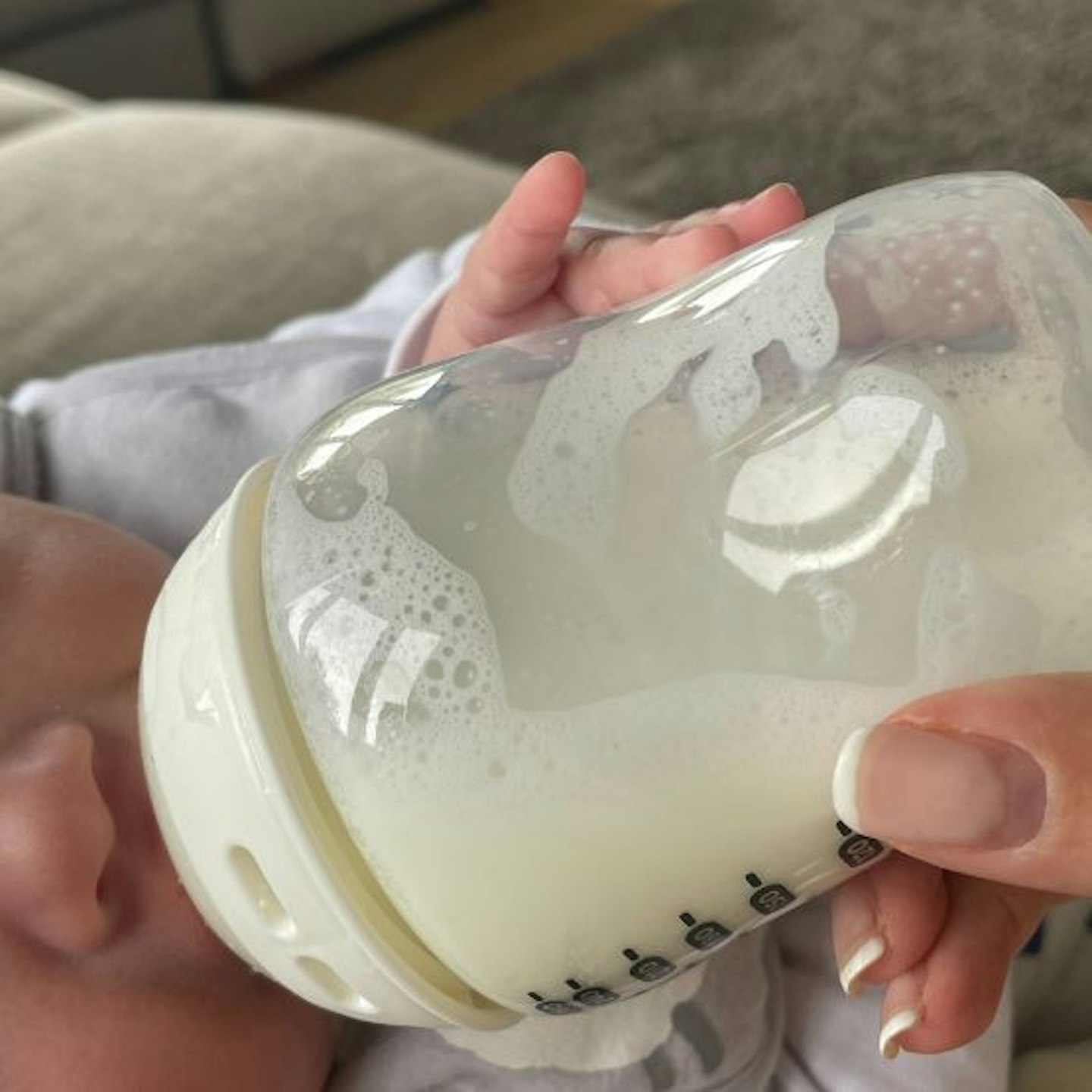 ©MOTHER&BABY
©MOTHER&BABYThe Tommee Tippee Natural Start Feeding Bottles were Shortlisted for Best Bottle Feeding Product at the 2021 Mother&Baby Awards.
The Tommee Tippee Natural Start Bottle (formerly known as Closer to Nature) is a good choice if you’re struggling with latch issues, as it features a breast-shaped teat that feels soft and natural to provide comfort and familiarity for your baby. Our mum tester, Chantelle, said, “This is a really good product for transitioning from breast to bottle. The soft teat really helps, and the shape of the bottle is really good for child development.”
Our parent testers found these bottles easy to use and clean, with a simple assembly process that can be managed single-handedly – perfect if you’re holding baby in the other hand as mum tester Fiona points out, “these bottles are extremely easy to use, they’re so simple to put together that I can do it with one hand whilst holding my baby.” The lightweight design and clear markings make it easy for parents to see how much milk is in there, with an anti-colic valve is ideal if your tot is struggling with colic. Mum tester Stacey agreed, saying, "There are very few components of the bottle making it so easy to put together. They are great to use as an on-the-go and busy Mum."
While some testers did find their baby struggled to adapt to this bottle from other brands, parents liked how easy it was to use thanks to how lightweight it is, the clear markings, and the anti-colic features. Mum tester Stacey found it gave her confidence to use bottles from a well-known brand, "Being from such a trusted brand, they give me confidence that I am providing my baby with the best." Reviews were mixed on cleaning, with one mum saying she'd like them to be a bit easier to clean, while Stacey gave them 5* for cleaning, noting, "I use the microwave to sterilise the bottles, which I have found so easy to do."
Read our full Tommee Tippee Natural Start Feeding Bottles review.
Pros
- Great value for money — six bottles come in a pack
- Available in a wide range of sizes, colours and decorations
- Anti-colic valves on the teat, which has a venting system that eliminates excessive airflow as your baby is eating
Cons
- Some testers found their baby found it difficult to adapt to this after other brands
| Volume: | 260ml |
| Materials: | BPA free, Phthalate free |
Best baby bottles for breastfed babies for colic reduction
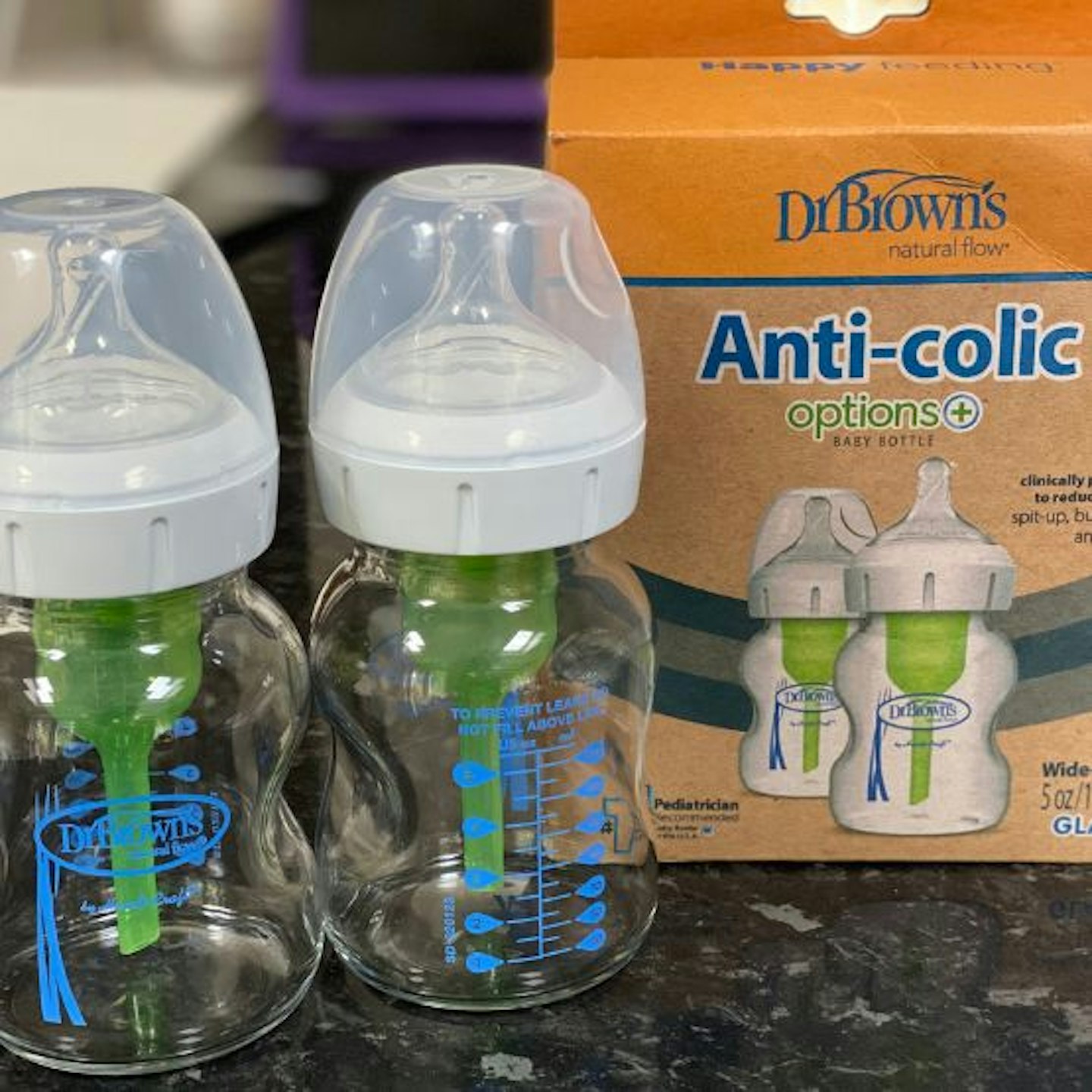 ©MOTHER&BABY
©MOTHER&BABYThe Dr Brown’s Anti-Colic Options+ Wide-Neck Baby Bottle 5oz was awarded Bronze for Best Product for Bottle Feeding at the Mother&Baby Awards 2024.
The contoured breast-like teat of these glass bottles helps your baby easily latch on, offering a more natural bottle-feeding experience. Our mum tester found this helpful, saying, "Very natural looking teat that resembles the breast so the transition from breast to the bottle was a non-stressful one"
Clinically proven to reduce windy colic, thanks to Dr Brown’s unique 100% vacuum-free vent system, this bottle offers both standard and anti-colic feeding options. The bottle is designed to adapt as they grow, making feeding sessions easy and comfortable. Our mum tester loved this feature for her child, commenting, “The fact that it has an anti-colic vent system and the flow is controlled by baby means a happier, more contented feed child.”
They're designed to allow you to use the bottle with or without the removable internal vent system, making it convenient for all babies’ needs. As one mum tester mentioned, "These bottles are great as they offer both standard and anti-colic feeding for babies."
Another mum tester, Danya, praised the wide neck of the bottles, commenting, "Having a 3-month-old and 2 other boys, the wide neck makes it easier for me to pump milk and put it in a bottle for when we are on the go. I’ve tried several bottles, but I found that the Dr Brown bottle worked best. My baby took to it quite quickly and the bottle didn’t leak at all."
Our parent testers found the bottle easy for their babies to grasp and hold, with our tester saying, “Baby is happy and able to hold the bottle himself but gripping it so encouraging self-feed too.” It keeps milk warm and offers a controlled flow, suitable for your baby's pace. Not only does it help with colic, but it also reduces wind, ensuring a more restful night's sleep for both baby and mum.
Danya found that they were easy to clean and felt durable. "The bottles are sturdy, and I can tell they will last a long time. The bottles are also very easy to clean. I was provided with 2 bottles and so it helps when I want to rotate, I always have a clean set."
They're available in a range of designs and can also be bought with either glass or plastic bottles, depending on your preference.
Read our full Dr. Brown’s Anti-Colic Options+ Wide-Neck Baby Bottle review.
Pros
- Dishwasher safe for easy cleaning
- Over 20 years of experience helping mums combat colic
- Contoured breast-like teat for a more natural feeding experience
- Wide neck bottle makes it easier to pump and put the milk in for feeding on the go
Cons
- Made from glass, therefore, needs to be handled with extra care
| Volume: | 150ml |
| Materials: | Glass, BPA free |
7.
Ember Baby Bottle System
Best baby bottle and warmer in one for breastfed babies
 ©MOTHER&BABY
©MOTHER&BABYThe Ember Self-Warming Baby Bottle System aims to change the way we prep a baby bottle and is ideal for both formula and expressed breastmilk. It's a two-in-one system with a bottle and warming system that uses convection current technology and triple-check safety features to heat the bottle to the right temperature.
As a mum to a five-year-old and a 2-month-old, our tester, Shriti, is adjusting to the busy life of being a mum of two and found the Ember Baby Bottle System helped make her life easier. She found it comforting that it's BPA-free, saying this "is a huge relief for me as a parent as it ensures the bottle is safe for my two-month-old to use.
It's designed to be anti-colic, and our mum tester found this to be true, saying, "The anti-colic vent system seems to be effective, as I've noticed a reduction in gas and fussiness." She also felt that it could help breastfeeding mums, noting "I also found the nipple design to be decent for transitioning between breast and bottle."
She found the self-warming aspect was a time saver, despite taking longer to warm than she'd expected. "The temperature control of the Ember Baby Bottle System is quite handy, as it generally keeps the milk at a consistent temperature, so it doesn't go cold if your baby wants a little break from feeding. I did, however, find that it took a little longer to warm up than I was expecting. Having the temperature control feature was extremely useful, especially for saving time. During late-night feedings, it was easier to ensure that the milk was at the right temperature.
When it comes to cleaning, Shriti found it generally straightforward, though the silicone sleeve was tricky to remove. "I found cleaning the Ember Baby Bottle System fairly straightforward too. The bottle is dishwasher safe which makes life so much easier! The bottle is designed with a wide neck too, so it helps with manual cleaning a lot more. The only thing I found difficult to clean was the silicone sleeve, as it can be tricky to remove and reattach."
All in all, she felt it offered value for money, despite the higher price tag, especially "if you're looking for a high-quality bottle with temperature control and anti-colic benefits."
Read the full Ember Baby Bottle System Review
Pros
- Contains different teat sizes for different flows as your baby gets bigger
- It comes with an app where you can prep, track and monitor feeds
- It heats to the correct body temperature and maintains the temperature
Cons
- It can leak if the lid isn't secured properly
| Volume: | 6oz or 178ml |
| Material: | Glass |
Comparison table
The table below compares our top recommended bottle, their key features and how they scored overall.
| Product Name | Key Features | Best for | RRP (£) | Our overall Rating |
|---|---|---|---|---|
| MAM UK Easy Start Anti Colic Bottles | Self-sterilising in 3 mins, anti-colic vented base, wide breast-like teat, BPA free, slow flow | Best overall baby bottles for breastfed babies | £18 (pack of 2) | 4.5/5 |
| Chicco Natural Feeling Bottle | Unique angled, soft silicone teat, twin anti-colic valves, wide neck, compatible with accessories | Best baby bottles for breastfed babies with a unique design | £15.69 | 4.5/5 |
| Nuk Perfect Match Baby Bottles | NUK Perfect Match clever teats (3 flow rates), anti-colic air system, soft breast-like feel | Best baby bottles for breastfed babies with built-in temperature control | £20.72 (pack of 3) | 4.5/5 |
| Tommee Tippee Advanced Anti-Colic Newborn Starter Set | Award-winning anti-colic vent, heat sensing tube, star valve for less air intake | Best baby bottles for breastfed babies for value for money | £38.99 (set) | 4.5/5 |
| Tommee Tippee Natural Start Feeding Bottles | Breast-like soft teat, anti-colic valve, easy latch design, BPA free | Best breast-shaped baby bottle for breastfed babies | £33.94 (pack of 6) | 4.5/5 |
| Dr Brown's Options+ Anti-Colic | Patented anti-colic internal vent system, preserves vitamins, can be used with/without vent | Best baby bottles for breastfed babies for colic reduction | £22.30 (pack of 2) | 4/5 |
| Ember Baby Bottle System | Safe warming and temperature control, battery operated, app connectivity | Best baby bottle and warmer in one for breastfed babies | £399.95 (full system) | 4/5 |
What to look for in bottles for breastfed babies?
Bottle teat design: We'd generally recommend a slow-flow teat as this mimics the natural flow of milk from the breast, which will be more familiar to your tot. However, a narrow-neck nipple with a gradual slope could be useful if you find your baby struggling to get their mouth around a wide-neck nipple teat.
Material: You will find that baby bottles come either in plastic or glass. Compared to glass bottles, plastic bottles are cheaper, more widely available, and easier for your baby to hold, especially as they are lightweight. Just be sure to go for BPA-free bottles if you do choose plastic, as these don't contain any harmful chemicals. Although glass bottles are heavier and can be pricier, they are much more eco-friendly. Unlike plastic, glass doesn’t stain or pick up odours. This option is also easier to clean and more long-lasting.
Pump compatibility: We're all for making life easy when possible, and there are some bottles that can connect to your breast pump, which are a lifesaver, as this means there's no need to worry about transferring your milk.
Teat size flow: If you're wondering which size teat is best when choosing a bottle for a breastfed baby, Dr Williams explains that "A slow-flow teat is better when introducing breastfed babies to a bottle, and round teats with a wide base are believed to encourage tongue and jaw movements similar to that of sucking at the breast."
Teat shape: "Look for a teat with a gradual slope (not one that suddenly flares out) so your baby can get a deep latch. You don’t want the teat too soft as baby will have a strong suction and flatten it but equally the material should not be too hard, like a plastic, as it may cause trauma," explains Midwife Jo.
Size: Choosing a bottle size for your breastfed baby depends on the size of your baby and how much they consume. Smaller bottles tend to be most suitable for newborns, as babies who feed from larger bottles may consume more milk, which can potentially lead to them overfeeding. Generally, "3–4 oz bottles are enough for most breastfed babies," recommends Midwife Jo and this seems to be a good starting point.
When to introduce a bottle to a breastfed baby?
Breastfeeding support group La Leche League suggest waiting until your baby is around 3-4 weeks old before introducing a bottle. This way, they're young enough to have established a good breastfeeding routine, and hopefully, this will eliminate the risk of nipple confusion.
Midwife Jo agrees, saying to not wait too long to introduce the bottle. "Stick with just one bottle every day to keep the skill going. And trust your baby — if they’re turning away or not interested, it’s okay to pause and try again later. Keep it low-pressure for both of you. The key to success is often patience and persistence!"
"Timing-wise, it’s best to introduce the bottle when your baby is alert and showing early hunger cues, such as rooting, sucking hands or lip smacking," says Dr Williams. "Do not wait until they are very hungry and irritated. Introducing a bottle should ideally be a gradual process that may take a couple of weeks."
She advises that to begin with it's worth "Choosing a time of day when it tends to be a more relaxed feed; for example, this could be after the morning nap, rather than the dreaded 3 am feed."
What should I do if my baby refuses to take a bottle?
Dr Williams tells us that "it’s not uncommon for babies to refuse a bottle at first and in some instances, babies will never take a bottle, and other strategies, such as cup-feeding, can be used."
She goes on to say that if your baby is struggling, it's important to stay calm. "The skin-to-skin approach can help keep the bottle relaxed, playful, and calm while introducing it. Try to make it a positive experience even if the baby doesn’t take any milk or even the teat at first." She notes that it's important to persevere gradually. "If the baby starts to refuse, stop at that point, and try to make further incremental steps the next day." She does on to say, "Don’t expect them to get the hang of it straight away, and never force the bottle into the baby's mouth. Sometimes it can help for someone else to feed the baby, when the baby can’t see, hear or smell the mother"
Midwife Jo's handy tip is to dip the teat in breast milk so it tastes familiar. "Sit your baby upright and hold the bottle horizontally — this helps slow the flow and keeps them in control. Gently touch the teat to their lips and let them latch at their own pace. Use paced feeding — tip the bottle up and down during the feed to mimic how they’d nurse at the breast."
Lastly, remember your experience will vary to the someone else's but trusting your own maternal instincts and with a little guidance from your baby, you'll work out what's best.
FAQs
How much milk should I feed a breastfed baby?
If you’re feeding your baby breast milk, try this simple calculation from breastfeeding expert Geraldine to work out how much milk to offer. "Simply multiply your baby’s weight in kg by 150ml and divide this number by your baby’s daily number of feeds – this will give you a low estimate of what your baby needs per feed," says Geraldine.
However, if you’re bottle-feeding your baby with formula, you'll need to use the higher calculation for an estimate of what your baby needs, as the formula isn’t as well absorbed or utilised by the body as breastmilk. "Multiply your baby’s weight in kg by 180ml and divide this number by your baby’s daily feeds," says Geraldine.
Can babies get confused between breast and bottle?
Dr Williams notes that "rather than ‘confused’, babies may certainly show a ‘preference’ for a bottle and especially if they are having any difficulties with flow from the breast." If a baby has to work hard at breastfeeding and then is offered a bottle, which is easier, with a flow that is faster and continuous, some babies may start to prefer the bottle. "And this could be a reason why they may start to refuse the breast in preference for bottle."
She notes that in this scenario "it may be advisable to address why they are finding breastfeeding difficult in the first place and to remember that babies are ‘hard-wired’ to breastfeed, so it’s likely that they will return to the breast with the right support."
How many bottles will I need?
This will depend on how often you're using a bottle to feed your baby. If you choose to stop breastfeeding and just bottle feed, you will need to factor in sterilising between feeds too. It's a good idea to start with 4 to 6 bottles and teats. If you only plan to use bottles once or twice a day, then it might be worth getting less.
What size bottle will my baby need?
To make it easy, bottles come in two sizes. Smaller ones hold 150mls (5 fl oz) and are best for newborns. As your baby grows, you can move to the larger size which holds 250ml (9 fl oz). But remember, each baby is different and some babies consume more milk, so it's best just to follow your baby’s feeding cues.
When should I change a bottle teat?
Teats come in slow, medium and fast flow. As your baby grows, they may need a stronger flow. and bigger teats come with more holes so babies can consume more milk. It's best to start with a slow flow teat so babies can comfortably swallow the milk and not cough or splutter. If milk dribbles down the side of the mouth, this is usually a good indication that the flow may be too fast for them.
Once they are older and more comfortable with bottle feeding, they can move to a medium flow and then to a fast flow. Once again, each baby is different and some may stay on a slow flow teat for longer. One thing to note is that teats can split as babies start to chew on them. If you see one is damaged, it's best to discard and change it.
Why you can trust us
At Mother&Baby, our mission is to provide accurate and reliable reviews, ensuring our readers receive honest and transparent information about the best products available.
Our testers are either pregnant, or real parents with a baby or toddler. This could be members of our editorial team, freelance parenting journalists or external reviewers from the Mother&Baby awards. Our Mother&Baby Awards are renowned in the industry and are among the most highly respected product awards for baby and parenting products. Every year, we arrange for thousands of independent parent reviewers to test the latest products on the market.
We don't accept payment from manufacturers for product reviews, and maintain our editorial independence. While we do work with commercial partners on advertorials, these will always be clearly labelled.
Our writers have full control over their content, ensuring that products are selected based solely on the needs of our readers. While we may earn commissions or other compensation from links on our website, this does not affect our product choices. These links allow us to continue offering valuable consumer advice, without compromising the integrity of our reviews. We are always honest in our reviews, and we won't recommend products that we wouldn't spend our own money on.
About the expert
Dr Zoe Williams is a practising GP based in London and also a mum of one. She's a regular on our screens answering medical questions on This Morning, and has a keen interest in preventive medicine, sports medicine and tackling chronic ill health through healthy eating and physical activity.
Midwife Jo Parkington is resident Midwife for Fraupow - the affordable and supportive breastfeeding brand - has been a midwife with the NHS and privately for over 30 years working as a midwife in all areas of maternity care.
About the author
Lorna White is the Products Editor for Mother&Baby. After running the Yours magazine website, specialising in content about caring for kids and grandchildren, Lorna brought her expertise to Mother&Baby in 2020. She has a keen interest in a range of topics, from potty training and nutrition to baby names and early development.
Keya Modessa, is our Senior Digital Writer and mother of two. She brings over a decade of experience from the digital realm to Mother&Baby. Having gained a BA Hons degree in Journalism and Sociology, Keya has worked across national publications including glossy women's mags, Food and Travel, and more recently digital lead at Muddy Stilettos.
